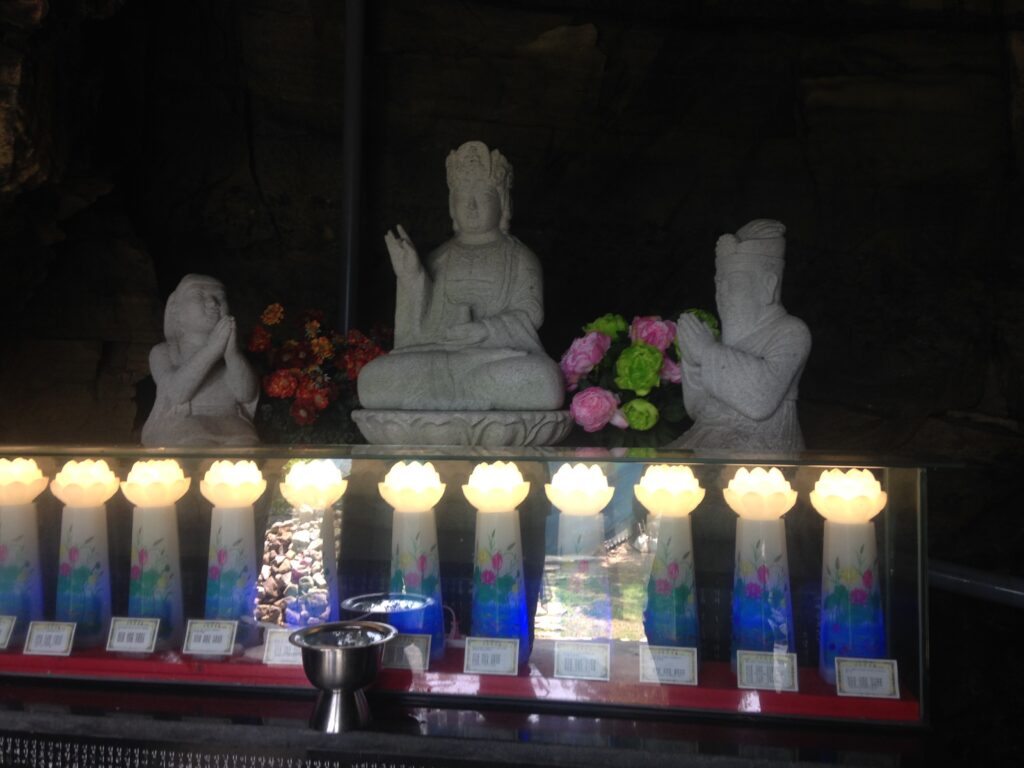By Brandon Ba
Located in Namhae, South Korea, Seongmyeong Sa 성명사/聖明寺 is situated on a forested hill overlooking a small fishing village. The surrounding area is mainly agricultural and relatively undeveloped. The closest city is about 1.5 hours away and a tourist beach resort is about 30 minutes away. The temple is nonetheless a pilgrimage site for visitors from around the country. There are also lay attendants that frequent the temple to cook, clean, and take care of it. There are shrine buildings that are similar to other Korean temples, as well as a unique cave-shrine for the bodhisattva Gwanseeum (Ch. Guanyin; Skt. Avalokiteśvara). In this cave, there is a natural spring which impresses ever-changing images on the cave. The natural spring water is collected into a bowl, and considered to be “medicinal” or “empowered water” (yagsu 약수/藥水), believed to cure diseases and purify the devout.
The resident abbot at Seongmyeong Sa teaches Korean medicine doctors, biomedical doctors, and religious figures about the therapies and remedies of what he calls “Buddhist medicine.” His knowledge is derived mainly from oral teachings from his Korean and Taiwanese monastic teachers, who taught him Korean and Tibetan methods respectively.
The abbot’s practice includes a Korean version of Buddhist medicine, which emphasizes a holistic approach and connects both physical and mental states (Baker 1994, 53). Treatments are prescribed based on the identified cause of disease (Baker 1994, 54). One such treatment is medicinal tea, which the abbot cultivates and prepares every autumn. He also uses physical exercises (chejo 체조/体操) for health and healing, which enable his hands and feet to heal by touch. The abbot’s students sometimes refer patients with difficult cases to the abbot, whom he treats with medicinal tea, exercises, and also ritual practices. He uses Medicine Buddha (Yaksa Yŏrae 약사여래/藥師如來, Sanskrit Bhaiṣajyaguru) rituals (Baker 1994, 61-71; Birnbaum 1989) and disperses illness-causing spirits, practices that are only performed by experienced monastics for healing difficult patients.
These practices originated from monks in the Silla period (57 BCE – 935 CE) who visited India. The role of Buddhist medicine in Korea has been limited after the Silla period due to secular Chinese-style medicine and recent popularization of biomedicine from the West (Baker and Lee 2017, 495).
Media

Entrance to the temple from the main road 
Main temple building 
Detail of a lattice window showing a temple guardian 
Cave shrine where a natural spring provides water for blessings 
Altar inside the cave shrine 
View from the temple
Scholarly Sources
- Baker, Don, and Hyunsook Lee. 2017. “Buddhist Health, Diet, and Sex Advice from Ancient Korea.” In Buddhism and Medicine: An Anthology of Premodern Sources, edited by Pierce Salguero, 494-500. New York: Columbia University Press.
- Baker, Don. 1994. “Monks, Medicine, and Miracles: Health and Healing in the History of Korean Buddhism.” Korean Studies 18: 50–75.
- Birnbaum, Raoul. 1989. The Healing Buddha. Revised edition. Boston, Massachusetts: Shambhala Publications, Inc.
Credits
This article is by Brandon Ba, with material from an interview with the head monk of Seongmyeong Sa conducted by Pierce Salguero.
